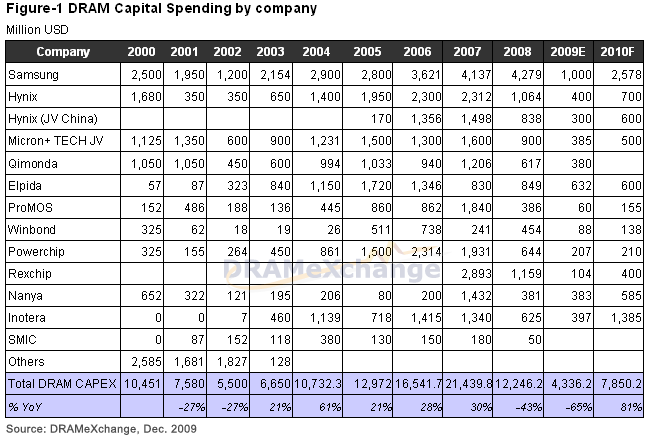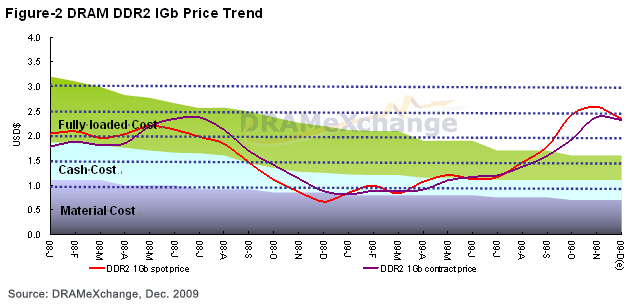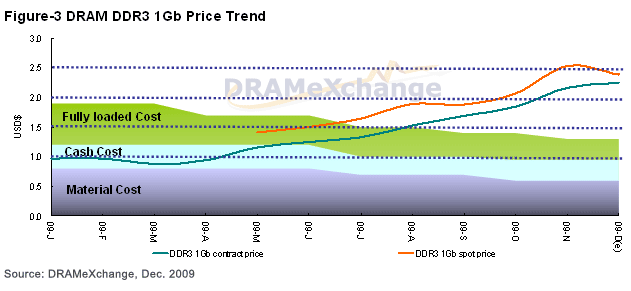Popular Keywords
- About Us
-
Research Report
Research Directory
Semiconductors
LED
Consumer Electronics
Emerging Technologies
- Selected Topics
- Membership
- Price Trends
- Press Center
- News
- Events
- AI Force
2009/12/24--------With the recovering PC shipment at 2009, DRAM shortage had accelerated since August and reach at the peak in October. Some PC-OEMs even spent US$55, 1Gb for US$3.25 equivalent, for DDR2/2GB module from module houses at spot market. Despite with the shortage ease in November and December, most PC-OEMs and PC-ODMs still indicate the strong shipment momentum while this situation resulted in the flat DRAM contract price during the periods.
According to DRAMeXchange, CAPEX for DRAM vendors will increase 80% YoY to US$7.85B from US$4.30B in 2009(Figure-1). However, this amount is still below the low CAPEX level at 2001~2003. We expect the CAPEX will likely grow to the level of US$10B-$12B in 2011~2012. We DRAMeXchange think the DRAM market will be more balanced in next two year given the discipline CAPEX enhancement, recovering PC shipment and other DRAM application growth. DRAM vendors can maintain their operational profitability.
According to DRAMeXchange, 1Q10 DRAM aggregate demand will be slightly below aggregate supply, which we think DRAM price will appropriately fall 10%~20%. Meanwhile, we also see the DDR3 will turn to the mainstream memory spectrum in 1Q10 while market share will account 60% and will likely reach 80% of commodity DRAM at 2H10. We DRAMeXchange expect that in 1Q10 DDR3 price will show the less price decline than DDR2 given the strong platform migration momentum.
According to DRAMeXchange, 2010 PC shipment YoY growth will be up to 13%.DT will merely grow 0.6%YoY to 120M units and 160M units for regular notebook with 22.5% YoY. Netbook will also grow 22% to 35M units as well. We DRAMeXchange expect that content per box growth rate will be up 16% to 2.92GB from 2.52GB in 2009 since 4GB is the standard spectrum for consumer models, 6GB for high level products and anticipated corporate replacement in 2H10. Also, we DRAMeXchange think DRAM will likely face serious shortage in 2H10 triggered by the hot PC sales and PC-OEMs may pull up the inventory level in 2Q09 to handle the shortage for 2H10. This situation will result in the warming up effect for slow season in 2Q10. DRAM price decline will likely be eased in 2Q10. That is, DRAM vendors will have great opportunity to remain profit for whole year.
As for Taiwanese DRAM vendors, Inotera&Nanya raised enough funds for the 50nm migration with the fully support from Formosa Group and their CAPEX will be up to US$1.8B in 2010. Accumulated CAPEX amount from other TW vendors such as PSC, Rexchip, ProMOS, Winbond, total TW DRAM CAPEX amount will reach US$2.7B, which is slightly higher than US$2.6B for Samsung. As for the technology migration, Inotera and Nanya will aggressively migrate to 50nm and probably produce few 40nm products with the cooperation relationship with Micron. Other TW DRAM vendors will focus on the relationship with Elpida. Although Elpida can migrate to 50nm this year due to the insufficient fund but we DRAMeXchange has seen that Elpida can accelerate the 4Xnm technology migration to lower the cost in 2H10 with the external fund assistance.
Technology migration plans of Powerchip (PSC) and Rexchip will likely follow Elpida’s plans but will be impact by the immersion equipment settlement issue. ProMOS will possibly pull up to full capacity with the outsourcing volumes for Elpida. Winbond current is aggressively negotiating cooperation with Elpida on various products such as commodity DRAM, mobile memory and specialty DRAM besides the previous plans on graphic memory.



Subject
Related Articles
Related Reports

